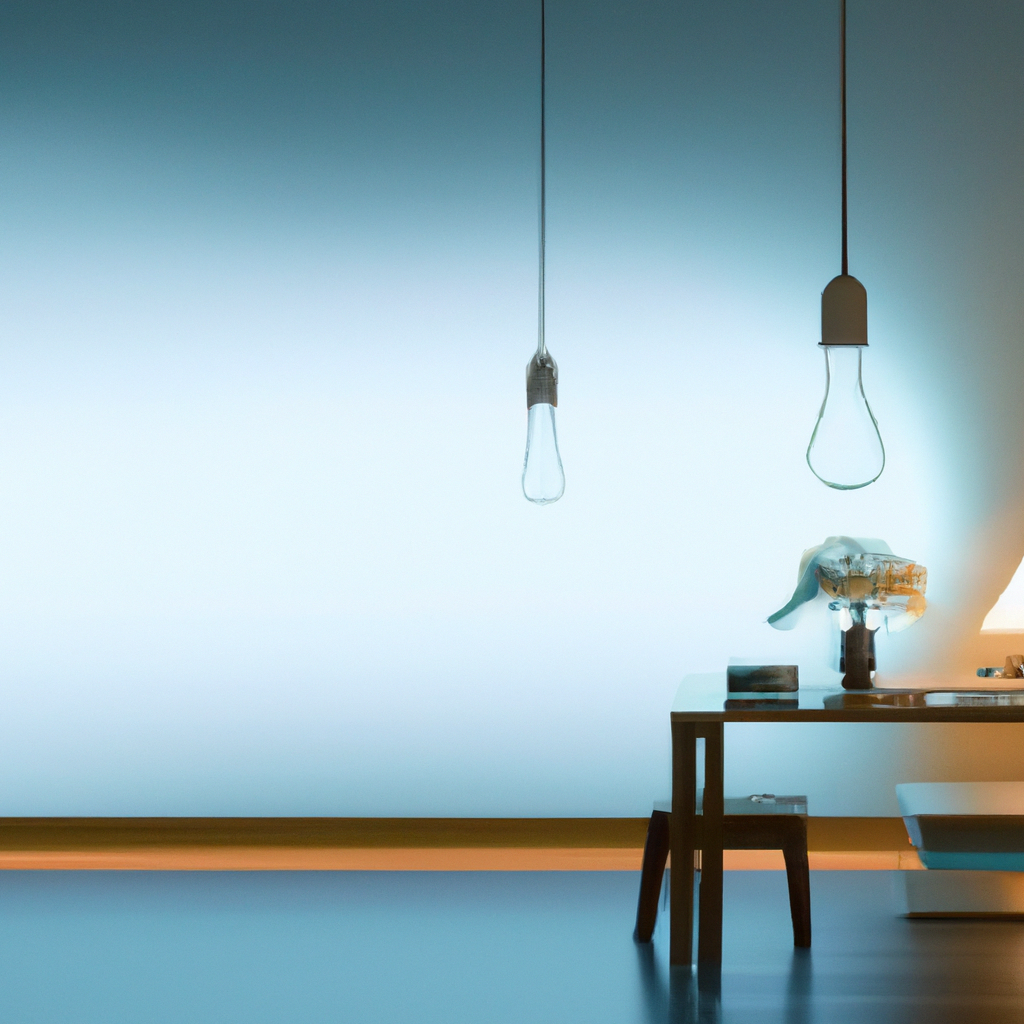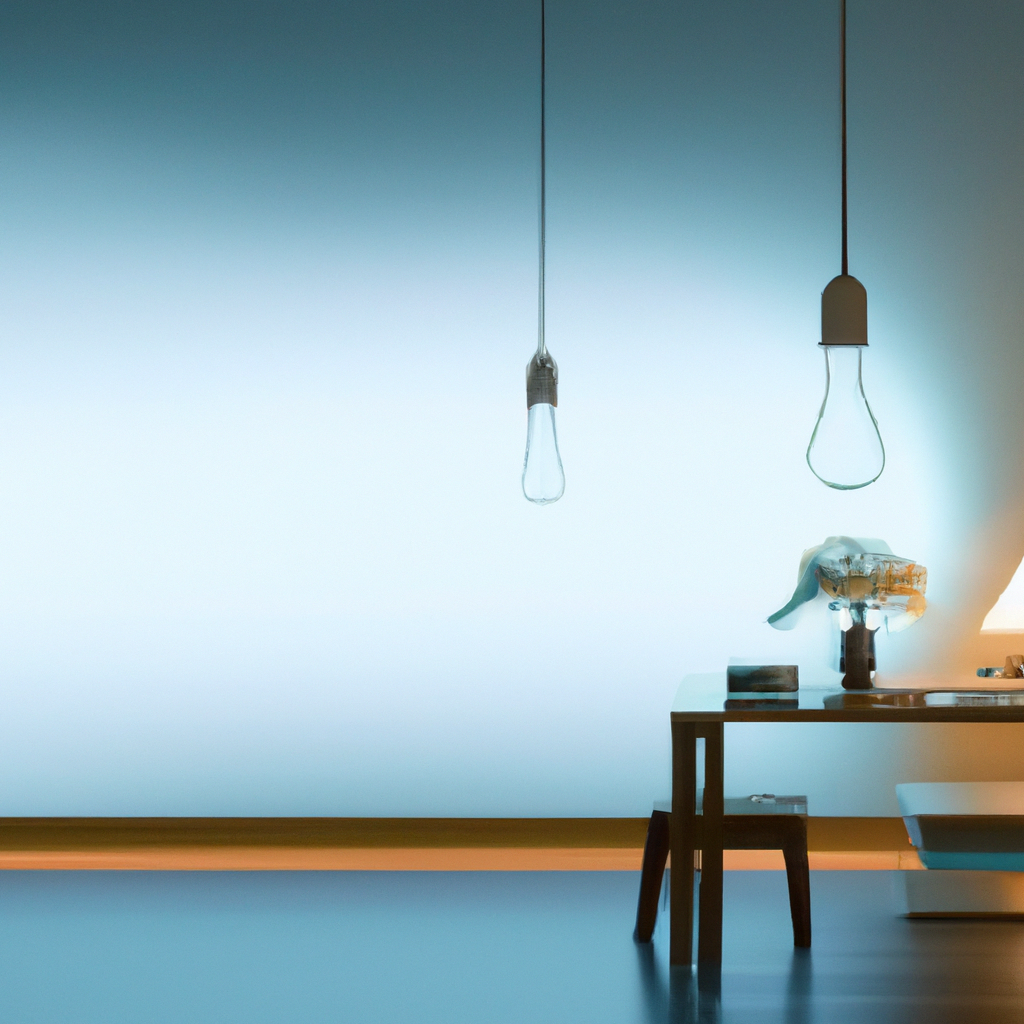Imagine waking up in the morning to a room filled with warm, gentle light that mimics the soft glow of a sunrise. As you go about your day, the lights adjust seamlessly, shifting from cool and bright in the morning to warm and dim in the evening. This may sound like a dream, but with the advancements in technology, smart lights have the potential to bring this vision to life. Can smart lights be programmed to simulate natural daylight? In this article, we’ll explore the possibility of creating lighting systems that replicate the subtleties and rhythms of natural light, and the potential benefits they could bring to our daily lives.
What are smart lights?
Smart lights are advanced lighting systems that can be controlled and programmed using smart devices such as smartphones or voice assistants. Unlike traditional lighting fixtures, smart lights have the capability to adjust various lighting parameters, such as color temperature, brightness levels, and light intensity, to create customized lighting experiences. By utilizing advanced technologies, smart lights can not only provide illumination but also simulate natural daylight, offering a wide range of benefits for individuals and indoor environments.
Definition of smart lights
Smart lights refer to lighting systems that can be controlled remotely using technology and can incorporate various features to enhance the lighting experience. These lights are equipped with wireless connectivity, allowing users to control them through dedicated mobile applications or compatible smart home systems. In addition to remote control, they often include advanced functionalities such as customizable color temperature, scheduling, and integration with other smart devices.
Features of smart lights
Smart lights offer a multitude of features that make them superior to traditional lighting fixtures. These features include:
- Adjustable color temperature: Smart lights can mimic the color temperature of natural daylight, which ranges from warm yellow to cool blue. This allows users to create the desired ambiance for different activities and times of the day.
- Dimmable brightness levels: Unlike standard light bulbs, smart lights can be dimmed to achieve the desired amount of illumination. This flexibility enables users to create a cozy and relaxed atmosphere or bright and energizing lighting.
- Voice and remote control: Smart lights can be controlled through voice commands or remotely using smartphones or tablets. This provides convenience and ease of use, allowing users to adjust the lighting without having to physically interact with the switches.
- Integration with smart home systems: Smart lights can seamlessly integrate with other smart devices in a home automation system. This integration enables users to synchronize their lighting with other smart features, such as motion sensors or voice assistants, to create a fully automated and interconnected experience.
Advantages of smart lights
Smart lights offer several advantages that make them a desirable lighting solution for both residential and commercial spaces. These advantages include:
- Energy efficiency: Smart lights are designed to be energy-efficient, consuming less power compared to traditional lighting systems. They often utilize LED technology, which is known for its low energy consumption and long lifespan.
- Cost savings: The energy efficiency of smart lights not only reduces electricity costs but also contributes to lower replacement and maintenance expenses due to their long lifespan.
- Convenience and flexibility: With smart lights, users have the flexibility to control the lighting according to their preferences. Whether it’s adjusting brightness levels or changing the color temperature, users can easily customize the lighting to create the desired ambiance.
- Improved security: Smart lights can be programmed to turn on and off at specific times, creating the illusion of an occupied home and enhancing security when residents are away.
- Environmental benefits: By reducing energy consumption and utilizing energy-efficient technologies, such as LED bulbs, smart lights contribute to reducing greenhouse gas emissions and minimizing the carbon footprint associated with lighting.
Importance of natural daylight
Natural daylight plays a crucial role in human well-being and overall health. Its impact goes beyond providing illumination; it influences our mood, productivity, and regulates our circadian rhythm. Understanding the importance of natural daylight is essential in realizing the benefits that can be achieved through its simulation using smart lights.
Health benefits of natural daylight
Exposure to natural daylight has various health benefits. It stimulates the production of vitamin D, which is essential for bone health and the immune system. Natural daylight also helps in regulating the body’s internal clock, promoting better sleep quality and mental health. It has been linked to improved cognitive function, reduced stress levels, and even faster recovery in hospitals.
Enhanced mood and productivity
Natural daylight has a significant impact on individuals’ mood and productivity. Studies have shown that exposure to natural light can improve the mood, leading to a sense of happiness and well-being. Furthermore, natural daylight has been found to enhance productivity and concentration, making it beneficial for office and work environments.
Circadian rhythm regulation
The circadian rhythm is the body’s internal clock that regulates various biological processes, including sleep-wake cycles, hormone production, and metabolism. Natural daylight serves as a powerful cue for the regulation of the circadian rhythm. Exposure to natural light during the day helps synchronize the body’s internal clock, promoting alertness and wakefulness during the day and restful sleep at night.

Simulating natural daylight with smart lights
Smart lights provide the opportunity to simulate natural daylight within indoor environments. By understanding color temperatures, adjusting brightness levels, controlling light intensity, and creating dynamic lighting effects, smart lights can successfully mimic the qualities of natural daylight.
Understanding color temperatures
Color temperature refers to the warmth or coolness of light emitted by a light source. Natural daylight has a color temperature that varies throughout the day, ranging from warm yellowish hues in the morning to cooler bluish tones during midday. Smart lights can replicate these different color temperatures, allowing users to adjust the lighting according to their preferred time of day or activity.
Adjusting brightness levels
Natural daylight doesn’t have a consistent level of brightness throughout the day, as it changes depending on external factors such as weather conditions. Smart lights can mimic this variability by allowing users to adjust the brightness levels. This flexibility enables users to recreate the desired level of illumination, whether it’s a gentle and subdued ambiance or a bright and invigorating light.
Controlling light intensity
Another aspect of natural daylight is the ability to control the intensity of light. Natural light is not uniformly distributed but instead varies in intensity throughout the day. Smart lights can imitate this characteristic by providing options to adjust the intensity of light emission. This feature allows users to create dynamic lighting conditions that simulate the changing intensity of natural daylight.
Dynamic lighting effects
Smart lights can go beyond standard illumination by offering dynamic lighting effects. These effects can simulate natural phenomena such as sunrise and sunset, creating a gradual transition of color temperature and brightness. By replicating these dynamic lighting changes, smart lights provide a more realistic and immersive simulation of natural daylight within indoor spaces.
Benefits of simulating natural daylight
Simulating natural daylight through smart lights offers numerous advantages for individuals and indoor environments. By improving well-being and mental health, increasing energy and alertness, and enhancing the overall indoor environment, the benefits of simulating natural daylight are far-reaching.
Improving well-being and mental health
The simulation of natural daylight has a positive impact on individuals’ well-being and mental health. Exposure to light that resembles natural daylight has been found to reduce symptoms of depression and seasonal affective disorder (SAD). It promotes a sense of calmness, reduces stress levels, and enhances overall mood and happiness.
Increased energy and alertness
Natural daylight is known to increase energy levels and boost alertness. Simulating natural daylight through smart lights can replicate this effect, making it beneficial for individuals who experience fatigue or lack of energy. Whether it’s in a residential or office setting, the ability to create a stimulating and energizing lighting environment can improve productivity and performance.
Enhanced indoor environments
Simulating natural daylight with smart lights can significantly enhance indoor environments. By adjusting the lighting to mimic the qualities of natural daylight, spaces can appear more vibrant, spacious, and inviting. The ability to create dynamic lighting effects adds depth and dimension to indoor spaces, creating a visually appealing and immersive experience for inhabitants and visitors.

Programming smart lights for natural daylight simulation
To effectively simulate natural daylight, programming smart lights is essential. By varying light color throughout the day, creating scenes for different activities, and integrating with smart home systems, users can customize their lighting experience to closely resemble natural daylight.
Variation of light color throughout the day
To recreate the changing color temperatures of natural daylight, smart lights can be programmed to gradually transition from warm hues in the morning to cooler tones during midday and back to warm tones in the evening. This variation in light color helps regulate the body’s circadian rhythm and provides a visually realistic simulation of natural light throughout the day.
Creating scenes for different activities
Smart lights offer the flexibility to create different lighting scenes for various activities. For example, a “relaxation” scene can feature warm, dimmed lighting to create a cozy ambiance, while a “task” scene can have brighter and cooler lighting to enhance focus and concentration. By programming different scenes, users can easily switch between lighting setups that match their current activity or mood.
Integration with smart home systems
Smart lights can be seamlessly integrated with other smart home systems, allowing for a more interconnected experience. Integration with motion sensors, voice assistants, or a central control hub enables users to automate lighting transitions based on occupancy, time of day, or other predetermined criteria. This integration further enhances the convenience and efficiency of simulating natural daylight.
Choosing the right smart lights for natural daylight simulation
When selecting smart lights to simulate natural daylight, several factors should be considered. Compatibility with daylight simulation programming, adjustable color temperature range, dimming capabilities, and the choice between smart lightbulbs or smart light fixtures are essential considerations.
Compatibility with daylight simulation programming
Not all smart lights are equipped with the necessary features and programming capabilities to effectively simulate natural daylight. It is crucial to choose lights that are specifically designed for daylight simulation and compatible with advanced programming options. This ensures greater control and accuracy in creating a realistic daylight simulation.
Adjustable color temperature range
The ability to adjust the color temperature of smart lights is vital in simulating natural daylight. Look for lights that offer a wide range of adjustable color temperatures, spanning from warm light (around 2700K) to cool light (around 6500K). This broad range allows for more precise control and customization of lighting to match the desired time of day or activity.
Dimming capabilities
Dimming capabilities enable users to adjust the brightness levels of smart lights, a crucial aspect of natural daylight simulation. Lights with dimming capabilities allow users to create the desired ambiance and replicate the changing brightness levels of natural daylight throughout the day. It is advisable to choose smart lights that offer smooth and flicker-free dimming options.
Smart lightbulb or smart light fixture
When selecting smart lights, consider whether to opt for smart lightbulbs or smart light fixtures. Smart lightbulbs can be easily installed into existing light fixtures, providing a cost-effective solution. On the other hand, smart light fixtures are self-contained lighting units that include built-in smart features. These fixtures often offer more advanced functionalities but may require professional installation.

Installation and setup of smart lights
Installing and setting up smart lights may vary depending on the specific product and manufacturer. However, there are general steps to follow to ensure a successful installation and configuration process.
Selecting suitable locations for fixtures
Before installation, carefully assess the intended locations for smart light fixtures. Consider factors such as the desired lighting coverage, the existing electrical wiring, and the accessibility for maintenance. Ensuring suitable locations for fixtures will contribute to optimal performance and lighting distribution.
Connecting smart lights to the network
Smart lights typically require a wireless connection to communicate with smart devices and the dedicated control application. The installation process may involve connecting the lights to a designated smart home network or syncing them with a central control hub. Follow the manufacturer’s instructions for connecting the lights to the network.
Configuring programming settings
Once the smart lights are connected to the network, proceed to configure the programming settings. This may involve downloading and syncing the dedicated mobile application or using a compatible smart home system. Adjust the color temperature ranges, brightness levels, and other desired parameters according to personal preferences and the goal of simulating natural daylight.
Challenges in simulating natural daylight with smart lights
While smart lights offer significant advantages in simulating natural daylight, certain challenges should be considered. These challenges include limited color accuracy, inconsistent light distribution, and the lack of natural light dynamics.
Limited color accuracy
While smart lights can replicate a wide range of color temperatures, achieving absolute color accuracy to perfectly simulate natural daylight can be challenging. Factors such as individual perception, color rendition capabilities of the lighting fixtures, and variations in light sources can lead to minor discrepancies in color accuracy.
Inconsistent light distribution
Achieving consistent light distribution throughout a space can be challenging when simulating natural daylight using smart lights. Some fixtures may cast shadows or create areas of varying brightness, which can affect the overall realism of the simulated daylight. Proper placement and selection of smart light fixtures can help minimize these inconsistencies.
Lack of natural light dynamics
Even with dynamic lighting effects, smart lights may still lack the true dynamics of natural daylight. Natural light changes not only in color temperature and brightness but also in direction, angle, and quality due to factors such as the sun’s movement and atmospheric conditions. While smart lights can mimic certain aspects of natural light dynamics, they may not fully capture the intricacies and natural variations.

Tips for effective natural daylight simulation
To optimize the simulation of natural daylight using smart lights, consider the following tips:
Understanding personal preferences
Experiment with different color temperatures, brightness levels, and lighting scenes to find the settings that best match personal preferences. Everyone may have different preferences and sensitivities to lighting, so it’s crucial to adjust the smart lights to the individual’s comfort and desired ambiance.
Scheduling lighting transitions
Set up schedules or timers to automate lighting transitions throughout the day. This ensures a seamless simulation of natural daylight and eliminates the need for manual adjustment. Consider synchronization with sunrise and sunset times to achieve a more realistic experience.
Integration with natural lighting sources
To enhance the simulated natural daylight, consider integrating smart lights with natural lighting sources such as windows and skylights. By taking advantage of natural light during the day and complementing it with smart lighting, a more immersive and realistic daylight simulation can be achieved.
Applications of smart lights simulating natural daylight
The ability to simulate natural daylight using smart lights has a wide range of applications. These include residential spaces, commercial and office settings, as well as healthcare and wellness facilities.
Residential spaces
In residential settings, simulating natural daylight with smart lights can create a more comfortable and inviting living environment. It enhances the aesthetics of the space, creates different moods for various activities, and contributes to overall well-being and mental health for occupants.
Commercial and office settings
Simulating natural daylight in commercial and office settings can significantly impact productivity, employee satisfaction, and well-being. By creating energizing and stimulating lighting environments, smart lights can enhance focus, reduce eye strain, and promote a positive working atmosphere.
Healthcare and wellness facilities
The simulation of natural daylight is particularly beneficial in healthcare and wellness facilities. It can promote faster recovery, improve patient well-being, and enhance the overall healing environment. Additionally, natural daylight simulation can benefit wellness spaces such as gyms and spas by creating a calming and soothing atmosphere.
In conclusion, smart lights offer the ability to simulate natural daylight, providing a wide range of benefits for individuals and indoor environments. By understanding the importance of natural daylight and utilizing the features and capabilities of smart lights, individuals can improve well-being, enhance productivity, and create visually appealing and immersive indoor environments. Proper programming, selecting the right smart lights, and considering tips and challenges can optimize the simulation of natural daylight and contribute to a healthier and more enjoyable lighting experience. Whether in residential, commercial, or healthcare settings, the possibilities of simulating natural daylight with smart lights are extensive.











